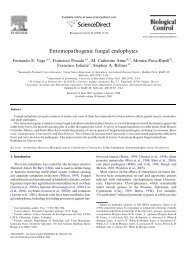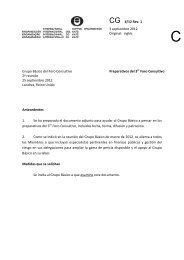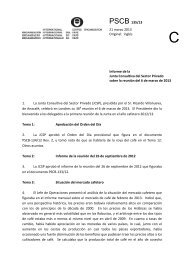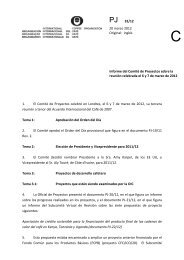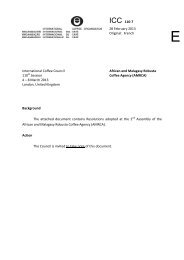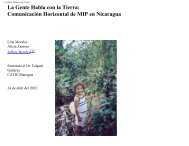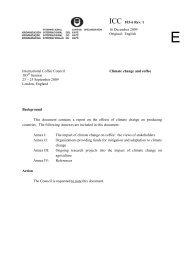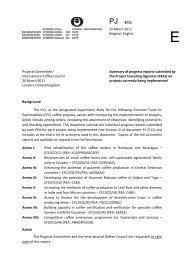Devouring profit - International Coffee Organization
Devouring profit - International Coffee Organization
Devouring profit - International Coffee Organization
You also want an ePaper? Increase the reach of your titles
YUMPU automatically turns print PDFs into web optimized ePapers that Google loves.
100<br />
robusta since both amount and distribution of rainfall throughout year are favourable<br />
for this kind of coffee. There are estimated to be about 1,000 ha of new clonal<br />
varieties in this region. In the other zones, with more seasonal rainfall, arabica prevails.<br />
These are the western Pacific coastal zone (Manabí province), the southern states<br />
(mainly Loja and El Oro), the central area (Esmeralda and Santo Domingo). In these<br />
zones, all but 25,000 ha of arabica is traditionally grown (i.e. not intensive production),<br />
with no more than 2,500 coffee trees per hectare, shade trees, little or no fertilization<br />
and old trees. According to information collected during the project, Ecuadorian coffee<br />
productivity ranges between 800 kg/ha of parchment coffee in the case of more intensively<br />
grown crops and 700 kg in the traditional ones.<br />
Millions of coffee bags (46 kg)<br />
4.0<br />
3.5<br />
3.0<br />
2.5<br />
2.0<br />
1.5<br />
1.0<br />
0.5<br />
0<br />
1963/64 1994/95 1999/00 2000/01 2001/02<br />
<strong>Coffee</strong><br />
Honduras<br />
This is one of the poorest countries in the western hemisphere, with a GNP per capita<br />
income of US$660 33 . Agriculture is very important in Honduras with 70% of the population<br />
linked to this sector. The main revenues come from exportation of bananas<br />
though coffee, cattle, sugarcane, lumber, tobacco and seafood, are significant contributors<br />
to the national income and foreign exchange.<br />
<strong>Coffee</strong> production in Honduras has been expanding (Figure 22). At the beginning of<br />
the 1960s, total production was about 500,000 sacks (46 kg of green coffee), by 1994/<br />
1995 it was 2 million and during the year 1999/2000 the exports rose to about 3.7<br />
Figure 22. Expansion of coffee production in Honduras over<br />
the last 40 years.<br />
million sacks. For the period 1985 - 1989 coffee exports were 25.6% of total exports<br />
(Palma et al., 1997). <strong>Coffee</strong> exports were valued at US$174 million for the coffee year<br />
1993/94; these figures demonstrate the key importance of the coffee sector to the<br />
33 World Bank, 1996 figures.




